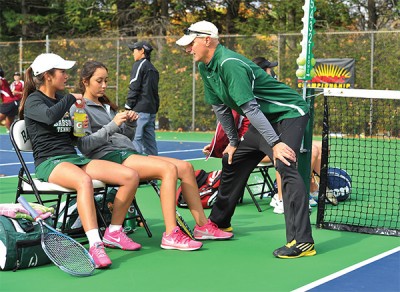
Photo: Mike Tureski
Coach Jim Berrigan, MBA’15, talks with Alex Freeman ’15 (left) and Yagmur Akgul ’18 (right).
Selected to finish third in the NEWMAC preseason poll and devoid of a conference championship for 11 years, the Babson women’s tennis team surprised its doubters by not only capturing a league title but also qualifying for the NCAA Tournament for the first time in program history.
The Beavers’ success began during the fall season, when the women shocked conference power MIT by beating them for just the sixth time in 46 meetings to claim only their second NEWMAC title and earn their first national ranking. “The senior leadership pushed our first-years to compete at a high level at the most important time of our fall season,” says head coach Jim Berrigan, MBA’15, who was named Northeast Region Women’s Coach of the Year by the Intercollegiate Tennis Association.
In another first, Babson boasted the Northeast’s top-ranked singles player, Yagmur Akgul ’18. “I had never played for a team before, and the idea of being a family made me more motivated to perform at 100 percent in every match,” says Akgul. “As I started beating very good players, I became even more motivated.”
However, the team’s prospects for the spring semester looked unfavorable when Akgul slipped on ice and broke her wrist, ending a stellar first-year campaign that included a 21-1 singles record and 19-3 doubles mark with partner Alex Freeman ’15. An injury also sidelined Jenny Quenard ’18, who had clinched the winning point during her team’s thrilling 5-4 comeback victory over MIT, for part of the spring. “After having an overwhelmingly successful fall, watching our team fall to injuries was mentally and emotionally draining,” says Freeman, “but we improvised, adapted, and overcame. The injuries made us a tougher team.”
Coach Berrigan says the Beavers initially struggled with their teammate losses, but about halfway through the spring season they began to play better and not think about the “what ifs” anymore. “When we arrived the day before the NCAAs,” he says, “we were excited to play and see how far we could go.” The team’s 5-0 victory over Colby-Sawyer gave the Beavers an NCAA Tournament win for the first time in program history. The win also tied this team with Babson’s 2003-2004 squad for the most single-season victories in program history.—Scott Dietz, associate director of athletics
]]>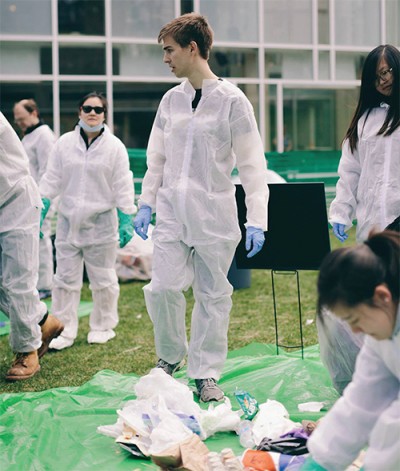
Photo: Sam Sklar ’17
Alex Davis, coordinator of the Babson Sustainability Office
This is not a normal magazine assignment.
The Babson Sustainability Office is holding a waste audit, which is another way of saying students will be digging through piles of refuse, with their hands, to assess rates of recycling and composting. I admire their dedication. Initiatives like this probably helped the College earn its gold STARS (Sustainability Tracking, Assessment & Rating System) rating. But I must admit the effort sounds, well, a bit gross. My assignment is to write about the audit—and participate.
I arrive to find students dressed in plastic gloves, shoe booties, and protective suits. They sift through waste from Horn Library, Reynolds, and the new residence hall, Park Manor West. Inexplicably, a DJ also is playing music. I immediately seek out Alex Davis, the office’s sustainability coordinator. I want to know what I’m getting into. “Is it fresh trash?” I ask him.
“Yes,” says Davis. “It was picked up last night.” I delicately ask my next question: “Is it smelly?” Davis says not to worry. “It’s only a day old. It’s not that bad. Trash isn’t instantly nasty.”
The participating students, a mix of fraternity members volunteering their time and Sustainability Office interns, go through the waste and separate it into three bags: one each for compost, recycling, and trash. “I see it as an archaeological dig,” says Hannah Esberg ’15. “You can tell a lot about behavior. You see people’s habits.”
Those habits aren’t always pretty. Lots of uneaten food lurks in the waste, as well as nearly full bottles of water and milk, and many recyclable objects were thrown in with the trash. Items that could have been given to Goodwill pop up in the residence hall rubbish: shoes, shirts, an unopened toothbrush.
The students handle the waste like pros. “It’s an interesting experience,” says Jake Shaver ’16. “It’s repulsive, but it needs to be done.” Meanwhile, DJ Sam Sternweiler ’17 continues playing high-energy hip-hop to keep the sorters sorting. Babson College Radio’s general manager, Sternweiler provides music for many campus happenings, but he usually performs at fairs and Roger’s Pub. “This is not a typical event,” he says.
Donning protective gear, I dig in with the students. I quickly have questions. Can you recycle aluminum foil? (Yes, if it’s clean.) What about plastic bags and snack wrappers? (No.) Occasionally, a wind kicks up, which scatters litter. “That makes it exponentially more difficult,” says Brandon Schwartz ’17. Picking through the waste isn’t too icky until we reach the end of the pile, where all that’s left is the dregs, of which I’ll spare the reader further details.
The sorted waste is weighed, and the numbers tell a story. For starters, a compost bin is needed in Horn since so many students eat there, Davis says. More education also is required about composting and recycling. Of the items originally thrown into trash cans, almost 40 percent could have been recycled. Another 36 percent could have been composted. “That’s wasted resources,” Esberg says. In total, the students sift through 213 pounds of waste. As the audit wraps up, I pass by the leftover free pizza and hurry to wash my hands.—John Crawford
]]>In June, Ro returned to Roger’s Pub and all those old memories. Since 1988 the pub has been serving up good times in Park Manor Central, but recent renovations meant the pub soon would close and relocate to Trim Dining Hall (plans are to revamp and reopen this fall). So alumni were invited back for one last bash to celebrate a campus institution where the drafts were $1, the chicken wings cost 25 cents, and the popcorn was free.
On that night, like Thursdays of yore, the pub was thumping. An auction was planned, and on the block were pub paraphernalia such as beer signs, stools, framed jerseys, and a section of the bar. Ro was joined by Jamie Burke ’08. The two had been roommates at Babson and remain close. “She’s eight months pregnant, and she came,” Ro says. “It wouldn’t be the same without her.” Burke stood next to Ro drinking a soda. “I thought it was a great idea to come back and see it one last time,” Burke says. “I’ll be the only sober person here.”
Many hugs were passed around, and countless fun evenings were remembered. Gwen Campero ’13, MSA’13, had celebrated her first job offer at the pub, while Jeff Brayer ’09 had spent many an hour playing Ms. Pac-Man. On this night, he was back at the video game. “It’s always free,” he says. Eric Yale ’07 recalled how during their last semester he and friends were at the pub all the time, counting down to graduation. “You got a job, the grades were fine, and you were in the home stretch,” he says. Yale also recalled the sounds and smells that made up the pub’s quintessence. “It was a combination of lukewarm beer, cheap cologne, the sound of flip phones, sticky shoes, and some sort of locker room odor,” he says.
Ross Simons ’13 and his fellow Babson Players would come to the pub every Tuesday night after rehearsal. Seven or eight of them would do karaoke together and sing Wagon Wheel or Don’t Stop Believin’. Now as he stood in the pub, people playing pool nearby, Simons had just realized that his shoes were sticking to the floor. “I never noticed it before,” he says. “It probably always was like that.” On the wall alumni were writing messages of goodbye to the pub, and Simons held a marker in his hand while trying to think of the right thing to say. “You were my home on many nights. I made real friends here,” wrote one alumnus. “To the many nights that were unforgettable, and the ones we’ll never remember,” wrote another.
As the night went on, many alumni reminisced with Patti Baptiste and Doug Titcomb, pub bartenders since 2003. Baptiste wore a T-shirt that read, “I  Pub.” “This,” she says, “used to be the place to be.”—John Crawford
Pub.” “This,” she says, “used to be the place to be.”—John Crawford
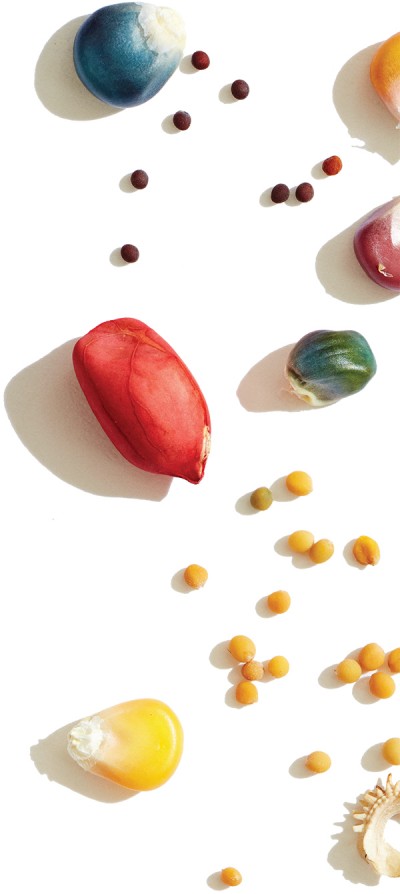
Photo: Winnie Au
Matthew Goldfarb, MBA’10, says he jumps out of bed every morning at 3 or 4, eager to work in the fields. He and his partner, Petra Page-Mann, started Fruition Seeds, an organic seed company in New York’s Finger Lakes region, in 2012.
Most seed companies either distribute, produce, or breed seeds. “Fruition is unique because we do all three,” says Goldfarb. “And there are few seed companies in the Northeast because of the challenging climate. Our focus is on northern hardiness, primarily New England and New York.”
The most basic part of the business is growing plants to seed maturity, which can take several months to several years, depending on the plant. Rather than taking the lettuce to market, for example, Fruition examines each plant for certain traits and characteristics such as disease resistance, color, and flavor. Desirable plants are allowed to flower, pollinate, and produce seeds. “Sixty percent of our seed is grown on our fields,” Goldfarb says, “and we collaborate with a dozen organic farmers and institutions like the University of Wisconsin and Cornell on various projects.”
Fruition owns 13 acres among four noncontiguous farms. “It’s important to keep certain crops isolated, one or two miles apart, so they won’t cross-pollinate,” says Goldfarb. Because Fruition is committed to organic land management and disease prevention, crops are rotated. “We produce and breed seed on only three acres at a time,” explains Goldfarb. “Most of the time the fields are planted with quick-growing cover crops with lots of biomass, such as oats, clover, and buckwheat, which we till down to add nutrients back to the soil.”
Once the seeds have been harvested, Fruition packages them all by hand. “We use very specific scoops and scales for seeds,” says Goldfarb. “It’s a time-consuming process, completely year-round.” Interestingly, winter is Fruition’s busiest season, packaging and selling seeds. The slowest time is late June to early July, after everything has been planted but it’s too early to harvest.
“We’re excited now about a new brand of sweet pepper, the Habanada, a no-heat habanero developed at Cornell,” says Goldfarb, “and also a particular variety of peanut that comes from Michigan’s Upper Peninsula. We grew it last year as a seed crop. It’s unusual because it’s hardy in cold weather.”
]]>
Photo: Webb Chappell
President Kerry Healey
When the Class of 2019 arrives on campus this fall, its members already will be part of Babson history by being the class that will graduate the year we celebrate our Centennial. That in itself is worthy of celebration, but even before arriving, the Class of 2019 has made history of its own.
The first sign this class was shaping up as one that would rewrite the record books began when Babson received an amazing 7,516 applications—an incredible 21 percent increase from a year ago. Clearly interest in a Babson education never has been higher nor our institutional reputation more well-regarded. The story gets better. While applications soared, so did the quality of applicants. The average SAT score for the Class of 2019 is 1936, another record and an increase of 28 points over last year’s score, the previous high. The competition for one of the 500 or so seats was as intense as it has ever been, and we experienced a record low acceptance rate of 26 percent.
For the first time in Babson history, the incoming class will be a majority of women, with 53 percent representation. As Babson’s first female president, I find this exciting and gratifying, and I’m thrilled to welcome so many aspiring women leaders and entrepreneurs into our community.
In addition to its robust academic profile, the Class of 2019 also reflects Babson’s commitment to diversity of all kinds. Students hail from 37 U.S. states, and 49 countries are represented, making the class 27 percent international. The class also includes 10 Global Scholars representing Egypt, Georgia, Hungary, Kenya, Kosovo, Morocco, Pakistan, Romania, Rwanda, and Turkey. Since launching in fall 2013, the Global Scholars program has raised nearly $6 million to attract some of the most promising entrepreneurial students from around the world. Their impact is evident throughout our community and made possible by the generosity of so many of you. We hope all students will benefit from living and learning alongside others from different backgrounds, cultural norms, and life experiences.
The Class of 2019 is ready to start their journey with an eye toward joining the more than 38,000 alumni from 114 countries that make up the global Babson network. Our official welcome of the Class of 2019 also marks the unofficial countdown to our Centennial anniversary. When it comes, we look forward to the impact this class will have as Babson’s newest generation of entrepreneurial leaders. They are eager to build on your legacy.

Kerry Healey
]]>Working for the Youth Entrepreneurial Leadership Programs at Babson’s Lewis Institute, Sarah Schwartz, program manager, and Janai Mungalsingh ’08, manager, recognized that connecting with students through schools and community programs would be more efficient than the current concept of working one on one with families and children. To introduce Lemonade Day to as many teachers as possible, after-school workshops were held in four Boston locations. Teachers also earned credits that apply toward professional development points.
The workshops guided teachers through the program, which aligns with Common Core requirements being taught in the classroom. The curriculum builds on math and literacy skills and introduces life skills such as financial literacy. It also encourages teamwork, leadership, and responsibility; participating students are encouraged to save some of their earnings, spend some on themselves, and share some by giving back to their communities.
Mungalsingh, who supports the educators as they deliver the curriculum to their students, says, “Some of the teachers may initially have been intimidated by the concept of entrepreneurial thinking, but many were pleasantly surprised when they realized they were doing it already.”
The workshops, for example, demonstrated how teachers could challenge students to think creatively and take the initiative to reach out when facing problems. Many classrooms already have students work in groups so students with different strengths can complement each other, effectively helping them learn together. “The training helped teachers to be more intentional about this,” says Mungalsingh, “to create more opportunities for students, not only for the Lemonade Day program itself but also during the entire school year.”
Schwartz says the program teaches “a proactive way to look at a situation, a way to change the trajectory, to help students think about improving their community and their world.”—Sharman Andersen
]]>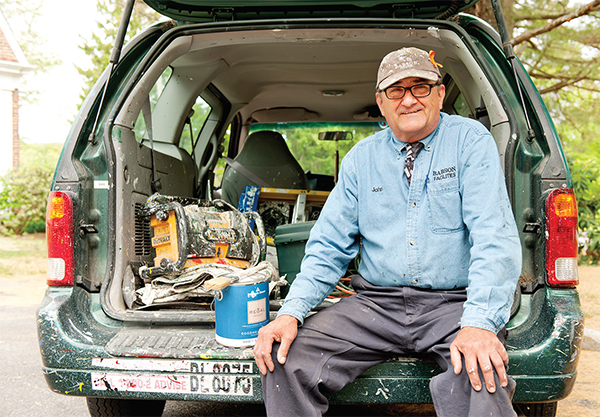
Photo: Webb Chappell
John Collins
When John Collins got out of the Army in 1972, he had no plan for what was next. He did some landscaping and plumbing work, but he wasn’t sure where his life was headed.
That’s when Jim Sullivan pulled Collins aside. The pair worked together at a Wellesley plumbing company, and Sullivan was a mentor of sorts to Collins. On a Friday, Sullivan said, “Go see my brother, Ed, on Monday.” Ed was the director of Babson’s physical plant. (His son, Terry, is a long-time facilities employee at Babson today.)
Doing as he was told, Collins came by the College on Monday. Forty-three years later, he’s still here. “That was it,” says Collins.
Collins is a painter. Spend any time on campus, and you’re sure to run into him. Actually, before you spot him, you first might hear his paint-splattered boombox playing anything from The Beatles to Journey to Lady Gaga. Then you might notice his green and worn minivan, which used to belong to the Athletics Department and now is loaded with cans and tarps.
When you stumble upon Collins himself, he’ll be wearing his standard uniform of bandanna and beret, and he’ll be painting, always painting. Offices, hallways, student rooms, trucks, floors, benches, the hockey rink. You name it, the man paints it. “You stay busy. You never run out of work,” Collins says. “The brush takes me everywhere. I meet a lot of people.”
As he paints, Collins often strikes up conversations. He’ll ask students how they’re doing, maybe buy them a cup of coffee. To those with trouble on their minds, he’ll counsel: “Don’t worry about it. Life is short.” Collins calls himself “the ambassador” since he works all over campus and is always keeping an eye out. He once overheard a student saying she needed to retrieve papers at her home in nearby Natick, but she didn’t have a way to get there, so he lent her his car. On another occasion, a woman had a flat tire right outside campus and was waiting for a tow truck, so he gave her something to eat and kept her company until help arrived.
For Collins, the school year has a rhythm. In the fall, he paints snowplows and truck beds in preparation for the wintery weather to come. Then as the days turn cold, his painting moves inside until the spring, when he focuses on the athletic fields and prepares the campus for Commencement. He loves seeing the students he has gotten to know in their caps and gowns. He marvels at how they’ve matured. “You really see them grow,” he says. “That’s my favorite time of year.”
Looking back on his years on campus, Collins recalls the co-workers who have retired or passed away and the good times they shared. He has filled the paint shop in Sullivan Hall with so many Babson mementos that the room feels like a mini-museum, with softballs and pucks from old games, pictures of former College presidents, and even a portrait of Roger Babson. “That’s Roger in his younger days,” Collins says. He has personal keepsakes as well: the boots his son wore while serving in Afghanistan, an old painting cap his mom made out of dungarees, and pictures of baseball great Lou Gehrig, whom he adores. “He represents people who do their jobs,” Collins says. “No complaining.”
Also lying in the paint shop are some of the signs Collins leaves after finishing a job. Instead of simply saying “Wet Paint,” the messages are personalized. Often they read, “The best thing about Babson and life is being part of it.”—John Crawford
]]>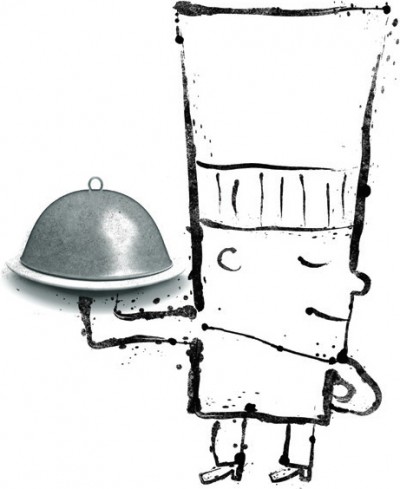
Illustration: Miguel Davilla/theispot.com
About 10 years ago, Dorothy Cann Hamilton, CEO and founder of the International Culinary Center, specializing in culinary and wine education, bought an inn in Connecticut. “It was a proper inn with a restaurant,” she says. “I thought since I ran a successful culinary school, I could run the inn. Well, of course, it was a disaster.”
Not a fan of losing money, nor one to accept defeat, Hamilton turned the inn and its restaurant around. But in the process, she also thought about what she should have known before tackling such an endeavor. “I thought about how does someone my age go back and learn the basic touchstones to opening a successful business?” she says.
Soon after, Hamilton began the Culinary Entrepreneurship program at ICC (formerly The French Culinary Institute), which offers a unique environment for students. Not only is ICC recognized for training some of the best chefs, including Bobby Flay and Christina Tosi, but it was founded on the tenet of a maximum amount of education in a minimum amount of time. “We’ve never followed a traditional model,” says Hamilton. So the resulting program, which focused on starting and managing restaurants, could be completed after 90 hours of course work.
Over the years, the program proved successful, but people interested in opening other food-related businesses, such as a bar or pastry shop, asked about possible courses. Chefs with established busi-nesses came seeking advice on how to scale up. Then Hamilton met Elaine Eisenman, dean of Babson Executive Education, and Candida Brush, professor of entrepreneurship, at a conference. “I told them I have all these budding entrepreneurs, and they need exactly what Babson does in spades,” says Hamilton. “Babson oozes entrepreneurship.”
So ICC and BEE connected, with BEE developing two four-day courses, one for startups and the other for scaling existing businesses, for anyone in the food and beverage industry. The StartUp Intensive covers a range of topics, including how to develop business models and plans, assess the marketplace, and build an effective team. It also helps participants understand themselves as entrepreneurs, such as what motivates them. The Grow and Scale Intensive will address such topics as what makes successful leaders, how to assess and improve operational processes, and how founders’ roles change as businesses evolve. To start, the courses will be offered on ICC’s New York City campus and at BEE. Eventually, plans are to expand to ICC’s West Coast campus in Campbell, Calif., and to offer the courses online as well.
“I do think that entrepreneurship is the word du jour,” says Hamilton. “You’re getting a lot of colleges and schools that don’t know much about it slapping a course together. But Babson studies entrepreneurship. Babson understands that it’s about more than being creative and persistent. You must be good at different skill sets to be a successful entrepreneur. It’s not quite what people expect.”—Donna Coco
]]>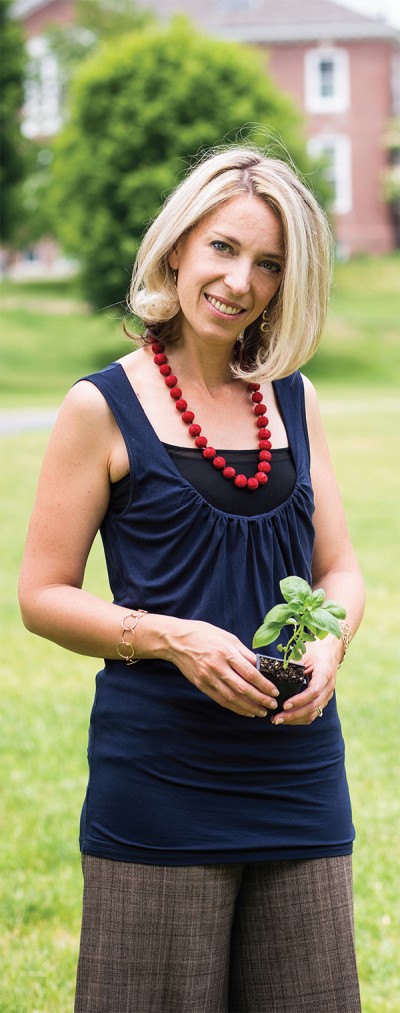
Photo: Pat Piasecki
Rachel Greenberger, MBA’11
Rachel Greenberger, MBA’11, leads a life of explorations. She studied in England and India, backpacked by herself around Europe, and has been to 18 countries. She has lived on both coasts and worked in advertising, restaurants, and travel agencies. She wrote, directed, and produced a short film that takes a modern look at Siddhartha, a classic tale of self-discovery. Now as director and co-founder of Babson’s Food Sol, Greenberger brings people together to explore the vast subject of food.
Describe Food Sol. Every person is part of the food machine. So we bring people together, anyone who eats food who wants to be in an empowered role with other people around food. Not activists, not arguing about big things, but people interested in some sort of personal action, or bite-size step around their food journey, which could be professional or could be purely personal or both. We bring them together in ways where they can give and take ideas, information, relationships, concepts. Whatever they want to share or ask, how can the rest of the group help? That’s what we do.
When did you become interested in food? My personal way into the food industry is from an animal welfare perspective, and that remains true. Twenty years ago, I first saw video footage of a concentrated animal-feeding operation and slaughterhouse, and I stopped eating beef and pork. Then I was at a film festival, and I saw a movie that showed the inside of a poultry facility, and I stopped eating all birds. And then a couple of summers ago I read Eating Animals, which talks about all of that and also the seafood industry, and I stopped eating fish and seafood. So I am very personally motivated by food politics, particularly animal welfare, but there are many threads out from that into environmental concerns and human rights and all sorts of things.
Your husband is from Turin, Italy. What has been his influence on you? The whole Italian influence on food is huge. So he’s got the culture and the familial bond aspect of food. I’ve got the politics and the data. We sort of balance each other out and share ideas.
How has your view of food changed? I know a lot more, which means I know a lot less because there’s a lot to know. I feel like the further down the rabbit hole I go, the more complicated and interconnected everything gets. Food is unequivocally the largest industry on the planet. Every single person participates actively, and that’s unusual.
Are you a good cook? My husband might not say so. He’s a wonderful cook. I’m learning, but I don’t have it in my bones.—Donna Coco
]]>Anderson may tell you about the day he was sitting in Boston and wondering how long a motorcycle trek to Seattle might take. The next day, he decided to find out. It took six and a half days.
Or he may tell you about how he organized a group to map thousands of miles of rivers, including the Rio Grande and the Colorado, using drones. His aim was to track water use and see which municipalities control this precious resource.
Or he may tell you about his interest in waste management and how he was invited to visit a Panamanian landfill, or about how he’s terrified of driving on India’s chaotic roads, or about his work with farmers, car companies, and health-care systems, or about the time he attempted to drive a motorcycle to the Arctic but found himself low on gas and face to face with a big moose blocking his path. “This is a sign,” Anderson thought, looking at the moose. “I’m turning around.”
The stories and ideas flow from him, and before you have the chance to ask a question or two— Why did you go to the Arctic? And what’s this about a moose?— he has moved on to something else. Anderson calls this torrent of reflections “ADD with a purpose” and says the stream is most intense after his morning coffee. He keeps white boards all over his house so he can write ideas as they pour out of him. “Things pop. I write them down and take a picture of it with my iPhone,” he says. “It’s my brain on the wall.”
Anderson’s curiosity fuels this fervor. “When you get down to the core of it,” he says, “I have a constant need to see and learn new things.” The world is an interconnected place, and Anderson is interested in the dense networks that bind together people, companies, and communities, and how all these connections are shaping business and our lives, both now and in years to come. “I follow people. I follow networks,” says Anderson, who before coming to Babson in 1996 worked for about 20 years as a consultant helping to turn around ailing companies. “I’m always trying to connect the dots. That’s how my brain works.”
When he examines networks in his consulting and research, Anderson gets out of the corporate office and into the field, examining every aspect of a company’s network, from suppliers to stores to customers. At Philips, for instance, he took executives to stores and showed them how difficult the company’s heavy highdefinition TVs were to handle. How could consumers be expected to buy them if they couldn’t take them home? “When you get locked up in your office, you don’t see this stuff,” Anderson says.
To go where the action is, Anderson has traveled to more than 40 countries, and he often works pro bono just so he can explore and learn about a particular industry. His travels have led him to interesting places. After the fall of communism, he found himself in Poland, touring an auto plant and dealing with managers who had no experience with capitalism or negotiating with the West. They ultimately brought in a local Catholic priest to talk to Anderson because, with the government having collapsed, the church was the only community leadership that was left. Lately, Anderson has examined how laparoscopic surgery is carried out in remote areas of Mongolia. He shot videos showing the technical and cultural challenges in performing the procedures, from the setup of equipment (insufficient electricity to run medical devices can be an issue) to the convincing of skeptical patients that the surgery is beneficial. He hopes the videos are used to educate future Mongolian doctors, as well as clinicians in developed nations who may want to bring such procedures to other far-flung areas.
Wherever he travels, Anderson tries to interact with people. He walks the streets, finds locals to show him around, visits homes and factories, and hangs out in gas stations. On the road, he uses motorcycles, so he’s not cut off from his surroundings. In rooms full of people, he watches their body language and eyes, tries to assess their relationships to each other, and listens. “You learn a lot,” he says. “I love what I’m doing. It’s all about the experience.”
Anderson isn’t afraid to go off the grid in search of that experience. In recent years, he has traveled to remote places on the “edge of electricity,” as Anderson describes them, seeking ventures enabled by the Internet’s ubiquity. He has found currency-exchange houses in the Chilean desert and a campsite equipped with Wi-Fi in the Yukon. “You’re in the middle of nowhere, and all of a sudden, a signal lights up,” he says.
Technology’s reach is extraordinary. Look at mobile phones, Anderson says. Some 7 billion people now are connected. What will this tremendous network of people mean for commerce, media, education, culture, and multitudes of other matters? In the classroom, Anderson examines the ramifications of this interconnectivity. The syllabus of his Extended Enterprise Management course reads, “You are participating in, and will soon lead, one of the largest global transformations in the history of the human species.” That’s a heady statement. Anderson receives emails from former students all the time about how they had a revelation about his class months, even years, after the fact.
How society will be transformed remains uncertain, but Anderson is optimistic. He has faith in people and the networks around them to unravel the problems we face. “In my travels I find that most people are good. If they are well-informed, they will figure it out,” he says. “With so many interconnected, we are figuring out problems quicker than ever.”
]]>